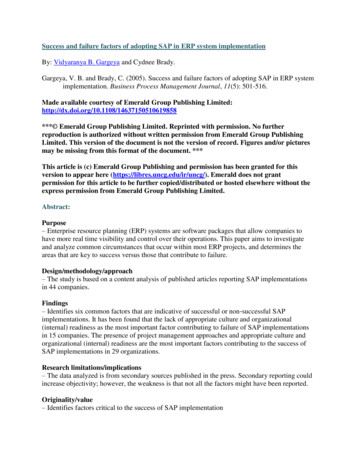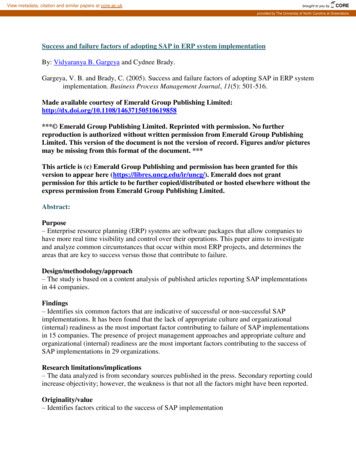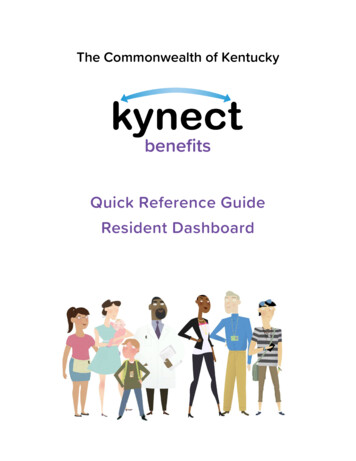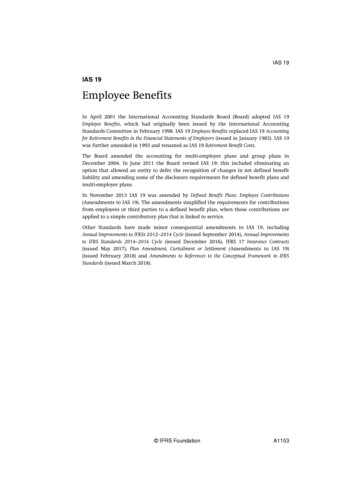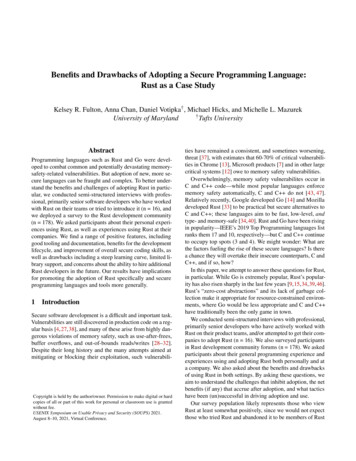
Transcription
Benefits and Drawbacks of Adopting a Secure Programming Language:Rust as a Case StudyKelsey R. Fulton, Anna Chan, Daniel Votipka† , Michael Hicks, and Michelle L. Mazurek† Tufts UniversityUniversity of MarylandAbstractProgramming languages such as Rust and Go were developed to combat common and potentially devastating memorysafety-related vulnerabilities. But adoption of new, more secure languages can be fraught and complex. To better understand the benefits and challenges of adopting Rust in particular, we conducted semi-structured interviews with professional, primarily senior software developers who have workedwith Rust on their teams or tried to introduce it (n 16), andwe deployed a survey to the Rust development community(n 178). We asked participants about their personal experiences using Rust, as well as experiences using Rust at theircompanies. We find a range of positive features, includinggood tooling and documentation, benefits for the developmentlifecycle, and improvement of overall secure coding skills, aswell as drawbacks including a steep learning curve, limited library support, and concerns about the ability to hire additionalRust developers in the future. Our results have implicationsfor promoting the adoption of Rust specifically and secureprogramming languages and tools more generally.1IntroductionSecure software development is a difficult and important task.Vulnerabilities are still discovered in production code on a regular basis [4, 27, 38], and many of these arise from highly dangerous violations of memory safety, such as use-after-frees,buffer overflows, and out-of-bounds reads/writes [28–32].Despite their long history and the many attempts aimed atmitigating or blocking their exploitation, such vulnerabili-Copyright is held by the author/owner. Permission to make digital or hardcopies of all or part of this work for personal or classroom use is grantedwithout fee.USENIX Symposium on Usable Privacy and Security (SOUPS) 2021.August 8–10, 2021, Virtual Conference.ties have remained a consistent, and sometimes worsening,threat [37], with estimates that 60-70% of critical vulnerabilities in Chrome [13], Microsoft products [7] and in other largecritical systems [12] owe to memory safety vulnerabilities.Overwhelmingly, memory safety vulnerabilites occur inC and C code—while most popular languages enforcememory safety automatically, C and C do not [43, 47].Relatively recently, Google developed Go [14] and Mozilladeveloped Rust [33] to be practical but secure alternatives toC and C ; these languages aim to be fast, low-level, andtype- and memory-safe [34,40]. Rust and Go have been risingin popularity—IEEE’s 2019 Top Programming languages listranks them 17 and 10, respectively—but C and C continueto occupy top spots (3 and 4). We might wonder: What arethe factors fueling the rise of these secure languages? Is therea chance they will overtake their insecure counterparts, C andC , and if so, how?In this paper, we attempt to answer these questions for Rust,in particular. While Go is extremely popular, Rust’s popularity has also risen sharply in the last few years [9,15,34,39,46].Rust’s “zero-cost abstractions” and its lack of garbage collection make it appropriate for resource-constrained environments, where Go would be less appropriate and C and C have traditionally been the only game in town.We conducted semi-structured interviews with professional,primarily senior developers who have actively worked withRust on their product teams, and/or attempted to get their companies to adopt Rust (n 16). We also surveyed participantsin Rust development community forums (n 178). We askedparticipants about their general programming experience andexperiences using and adopting Rust both personally and ata company. We also asked about the benefits and drawbacksof using Rust in both settings. By asking these questions, weaim to understand the challenges that inhibit adoption, the netbenefits (if any) that accrue after adoption, and what tacticshave been (un)successful in driving adoption and use.Our survey population likely represents those who viewRust at least somewhat positively, since we would not expectthose who tried Rust and abandoned it to be members of Rust
forums. That said, our survey population comprised peoplewith a variety of general and Rust-specific development experience. 26% of respondents had used Rust for less than oneyear and they often held similar opinions to more experiencedRust users. Our results uncovered a wide variety of specificchallenges and benefits which can provide novel insights intothe human factors of secure language adoption.Participants largely perceived Rust to succeed at its goalsof security and performance. Other key strengths identifiedby participants include an active community, high-qualitydocumentation, and clear error messages, all of which makeit easy to find solutions to problems. Further, participantsindicated that overall Rust benefits the development cycle inboth speed and quality, and using Rust improved their mentalmodels of secure programming in ways that extend to otherlanguages.However, participants also noted key drawbacks that caninhibit adoption, most seriously a steep learning curve toadjust to the paradigms that enforce security guarantees. Otherconcerns included dependency bloat, limited library support,slow compile times, high up-front costs, worries about futurestability and maintenance, and apprehension about the abilityto hire Rust programmers going forward. For our participants,these negatives, while important, were generally outweighedby the positive aspects of the language.Lastly, participants offered advice for others wanting to advocate adoption of Rust or other secure languages: be patient,pick projects playing to the language’s strengths, and offersupport and mentorship during the transition.Analyzing our findings, we offer recommendations aimedat supporting greater adoption of Rust in particular and secure languages generally. The popularity of Rust with ourparticipants highlights the importance of the ecosystem —tooling, documentation, community — when developing secure languages and tools that users will actually want to use.Our results also suggest that perhaps the most critical pathtoward increased adoption of Rust in particular is to flattenits learning curve, perhaps by finding ways to gradually traindevelopers to use Rust’s ownership and lifetimes. Further, wefind that much of the cost of adoption occurs up front, whilebenefits tend to accrue later and with more uncertainty; security advocates should look for ways to rebalance this calculusby investing in a pipeline of trained developers and contributing to the longevity and stability of the Rust ecosystem.2BackgroundRust is an open-source systems programming language created by Mozilla, with its first stable release in 2014. Rust’screators promote its ability to “help developers create fast,secure applications” and argue that Rust “prevents segmentation faults and guarantees thread safety.” This section presentsRust’s basic setup and how it aims to achieve these benefits.For those with a deeper interest, we recommend the tutorialoffered in the official Rust Programming Language Book [21].2.1Core features and ecosystemRust is a multi-paradigm language, with elements drawn fromfunctional, imperative, and object oriented languages. Rust’straits abstract behavior that types can have in common, similarly to interfaces in Java of typeclasses in Haskell. Traitscan be applied to any type, and types need not specificallymention them in their definitions. Objects can be encodedusing traits and structures. Rust also supports generics andmodules, and a sophisticated macro system. Rust’s variablesare immutable by default: once a value is bound to a variable, the variable cannot be changed unless it is specificallyannotated as mutable. Immutability eases safe code composition, and plays well with ownership, described shortly. Rustalso enjoys local type inference: types on local variables aregenerally optional, and can be inferred from their initializer.Rust also supports tagged unions (“enums”) and patternmatching, which allow it to, for example, avoid the need fora null value (the “billion dollar mistake” [19]).Rust has an integrated build system and package manager called Cargo, which downloads library packages, calledcrates, as needed, during builds. Rust has an official community package registry called crates.io. At the time of writing,Crates.io lists more than 49,000 crates.2.2Ownership and LifetimesTo avoid dangerous, security-relevant errors involving references, Rust enforces a programming discipline involvingownership, borrowing, and lifetimes.Ownership. Most type-safe languages use garbage collection to prevent the possibility of using a pointer after itsmemory has been freed. Rust prevents this without garbagecollection by enforcing a strict ownership-based programmingdiscipline involving three rules, enforced by the compiler:1. Each value in Rust has a variable that is its owner.2. There can only be one owner at a time for each value.3. A value is dropped when its owner goes out of scope.An example of these rules can be seen in Listing 1. In thisexample, a is the owner of the value “example.” The scopeof a starts when a is created on line 3. The scope of a endson line 5, so the value of a is then dropped. In the secondblock of code, x is the initial owner of the value “example.”Ownership is then transferred to y on line 11, which is whythe print on line 13 fails. The value cannot have two owners.Borrowing. Since Rust does not allow values to have morethan one owner, a non-owner wanting to use the value mustborrow a reference to a value. A borrow may take place solong as the following invariant is maintained: There can be (a)just one mutable reference to a value x, or (b) any number of
123456{//make a mutable string and store it in alet mut a String::from("example");a.push str(" , text"); //append to a}//scope is now over so a’s data is dropped7891011121314{//make a mutable string and store it in xlet mut x String::from("example");{//make immutable reference to xlet y &x; //allowed//make second immutable reference to xlet z &x; //alllowedprintln!("x is {}. y is {}", x, y) //allowedx.push str(" , text"); //fails//make mutable reference to xlet mut a &mut x; //fails} //drops y and z; x owner againx.push str(" , text"); //allowed{//make mutable reference to xlet mut a &mut x; //alloweda.push str(" , text"); //allowedx.push str(" , text"); //fails//make second mutable reference to xlet mut b &mut x; //fails} //drops a; x is owner again}1234567{//make a mutable string and store it in xlet x String::from("example");let y x; //moved ownership to yprintln!("y is {}", y); //allowedprintln!("x is {}", x); //fails}Listing 1: Examples of how ownership works in Rust8910111213141516171819immutable references to x (but not both). An example of therules of borrowing can be seen in Listing 2. In this example, amutable string is stored in x. Then, immutable references aremade (“borrowed”) on lines 6 and 8. However, the attempt tomutate the value on line 10 fails since x cannot be mutatedwhile it has borrowed (immutable) references. Line 12 failsin the attempt to make a mutable reference: x cannot haveboth a mutable and an immutable reference. Once we reachline 13, the immutable references to x have gone out of scopeand been dropped. x is once again the owner of the value andpossesses a mutable reference to the value, so line 14 does notfail. In the second code block, starting on line 15, a mutablereference is made to the value. Attempts to make a secondmutable reference on lines 19 and 21 fail because only onemutable reference can be made to a value at a time.The ownership and borrowing rules are enforced by a partof the Rust compiler called the borrow checker. By enforcingthese rules the borrow checker prevents vulnerabilities common to memory management in C/C . In particular, theserules prevent dangling pointer dereferences and double-frees(only a sole, mutable reference may be freed), and data races(a data race requires two references, one mutable).Unfortunately, these rules also prevent programmers fromcreating their own doubly-linked lists and graph data structures. To create complex data structures, Rust programmersmust rely on libraries that employ aliasing internally. These libraries do so by breaking the rules of ownership, using unsafeblocks (explained below). The assumption is that libraries arewell-vetted, and Rust programmers can treat them as safe.Lifetimes. In a language like C or C , it is possible tohave the following scenario: (1) you acquire a resource; (2)you lend a reference to the resource; (3) you are done withthe resource, so you deallocate it; (4) the lent reference to theresource is used. Rust prevents this scenario using a conceptcalled lifetimes. A lifetime names a scope, and a lifetimeannotation on a reference tells the compiler the referenceis valid only within that scope. For example, the lifetime ofvariable a in Listing 1 ends on line 5 where the scope of a20212223Listing 2: Examples of how borrowing works in Rustends. Similarly, the lifetime of a in Listing 2 ends on line 22.2.3Unsafe RustSince the memory guarantees of Rust can cause it to beconservative and restrictive, Rust provides escape hatchesthat permit developers to deactivate some, but not all, ofthe borrow checker and other Rust safety checks. Weuse the term unsafe blocks to refer generally to unsafeRust features. Unsafe blocks allows the developer to: Dereference a raw pointer Call an unsafe function or method Access or modify a mutable global variable Implement an unsafe trait Access a field of a unionUnsafe functions and methods are not safe in all cases or forall possible inputs. Unsafe functions and methods can alsorefer to code that a developer wants to call that is in anotherlanguage. Unsafe traits refer to traits with at least one unsafevariant. Lastly, unions are like structs but only one field ina union is used at a time. To use unsafe blocks, the relevantcode construct is labeled with keyword unsafe.3MethodTo understand the benefits and drawbacks to adopting Rust,we conducted semi-structured interviews with senior and professional software engineers working at technology companies who were using Rust or attempting to get Rust adopted.To examine the resulting findings in a broader ecosystem,we then distributed a survey to the Rust community through
Sect.Description and Example Questions1Technical Background (General, and Rust) How long have you been programming? How long have you been programming in Rust?2Learning and using Rust How easy or difficult did you find Rust to learn? How would you rate the quality of available Rust docs? When I encounter a problem or error while working in Rust,I can easily find a solution to my problem?3Work (general), and using Rust for work Did anyone at your employer have apprehensions aboutusing Rust? What one piece of advice would you give to someone whois trying to get Rust adopted?4Comparing Rust to other familiar languages How would you rate the quality of Rust compiler and runtime error messages compared to [chosen language]?5Rust likes/dislikes & unsafe blocks Which of the following describes your use of unsafe blockswhile programming in Rust?6Porting and interoperating with legacy code What language(s) have you ported from?7Demographics about participants Please select your highest completed education levelTable 1: Survey sections and example questions.various online platforms.3.1Interviews and SurveysInterview protocol. From February through June 2020,we conducted 16 semi-structured interviews via videoconferencing software.Each interview included two phases. Phase one asked theparticipants how they discovered and learned Rust, as wellas about instances when they or their company decided touse Rust for projects (or not) and why. In the second phase,we asked more technical questions about programming withRust, including what features of the language/ecosystem theylike/dislike compared to other familiar languages, as well asopinions about features relating to Rust’s security, such asownership and unsafe blocks.Each session lasted about an hour, giving participants achance to share detailed experiences. The full interview protocol is given in Appendix A.Survey. The survey was designed to mirror the interviews,with closed-item answer choices inspired by answers fromthe open-ended interview questions. The survey was brokeninto seven sections; Table 1 tabulates the sections and provides some example questions. The full survey is given inAppendix B. It was active from July to September 2020.Recruitment. To recruit for the interviews, we contacteda longtime member of the core Rust team and asked them toconnect us with software engineers who were active membersor leaders of teams using or adopting Rust at their employers. From these initial referrals, we snowball-sampled moreinterviewees (asked participants to refer us to peers). We alsorecruited participants referred to us by colleagues, and contacted people and companies quoted or listed on the Rust website [35]. We focused on recruiting participants with senior,leadership, or other heavily involved roles in the Rust adoptionprocess. We interviewed participants until we stopped hearingsubstantially new ideas, resulting in a total of 16 participants.This sample size aligns with qualitative best practices [16].To recruit participants for the survey, we advertisedon several Rust forums and chat channels: Redditchannel r/rust; Rust Discord community channelsembedded, games-and-graphics, os-dev, gui-and-ui,and science-and-ai; Rust Slack beginners channel; RustFacebook Group; and the official Rust Users Forum. Thosewho wanted to participate were directed to follow a link inthe notice that took them directly to the survey.Ethics. Both the interview and the survey were approvedby University of Maryland’s ethics review board. We obtainedinformed consent before the interview and the survey. Giventhat we were asking questions about their specific companiesand the work they were doing, participants were informed thatwe would not disclose the specific company they worked for.They were reminded that they could skip a question or stopthe interview or survey at any time if they felt uncomfortable.3.2Data analysisOnce the interviews were complete, two team members transcribed the audio recordings and then analyzed them usingiterative open coding [8]. The interviewer and the other teammember independently coded the interviews one at a time,developing the codebook incrementally and resolving disagreements after every transcript. This process continueduntil a reasonable level of inter-rater reliability was reachedmeasured with the Krippendorff’s α statistic [22]. After seveninterviews, the two researchers achieved a Krippendorff’sα 0.80, calculated using ReCal2 [11]. This level of agreement is above the commonly recommended thresholds of0.667 [18] or 0.70 [23] for exploratory research and meets themore general minimum threshold recommended by Krippendorff of 0.8 [22]. Once a reliable codebook was established,the remaining nine interviews were evenly divided among thetwo researchers and coded separately.We report the results of our closed-response survey questions using descriptive statistics. While we did not have anyquestions as specific attention checks, we evaluated the responses for completeness to ensure that we removed all lowquality responses. We did not remove many responses as canbe seen in Section 4. Since our work is exploratory, we did
not have any hypotheses, so we do not make any statisticalcomparisons. Free response questions from the survey wereanalyzed by one researcher using the same codebook fromthe interview. When new codes were added to the codebook,they were back-applied to the interviews.Throughout the following sections, we use I to indicate howmany interview participants’ answers match a given statement,and use S to denote how many survey participants’ answersdo, either as a percentage (closed-item questions) or count(open-ended ones). We report on interview and survey resultstogether, as the results generally align. We report participantcounts from the interviews and open-ended items for context,but not to indicate broader prevalence. If a participant did notvoice a particular opinion, it does not necessarily mean theydisagreed with it; they simply may not have mentioned it.3.3LimitationsOur goal with the interviews was to recruit people who hadsubstantial experience, and preferably a leadership role, inattempting to adopt Rust at a company or team. We believe wereached the intended population. Only one interviewee failedto see Rust adopted at their employer, but all intervieweesfaced similar adoption challenges.For the surveys, our goal was to reach a broad variety of developers with a range of Rust experiences, in order to capturethe widest range of benefits and drawbacks. We did reach participants with a wide range of Rust experience, in part becausewe targeted many Rust forums, including some specificallyfor beginners. However, because all of these forums are aboutRust, we may not have reached people who have tried Rust butabandoned it, or those who considered it but decided againstit after considering potential pros and cons. In addition, theseforums are likely to overrepresent Rust enthusiasts comparedto those who use the language because they are required to.Further, there could be self-selection bias: because we statedour goal of exploring barriers and benefits to adopting Rustwhen recruiting, those with particular interest in getting Rustadopted may have been more likely to respond.Taken together, these limitations on our survey populationsuggest that our results may to some extent overstate Rust’sbenefits or may miss some drawbacks that drive people awayfrom the language entirely. Nonetheless, our results uncovereda wide variety of challenges and benefits that provide novelinsights into the human factors of secure language adoption.Given the general difficulty of recruiting software developers [36], and the particular difficulty of reaching this specificsubpopulation, we consider our sample sufficient.4ParticipantsInterview participants. We interviewed 16 people whowere active members of teams using or adopting Rust at theircompany. Our participants mostly held titles related to software development (I 12) and worked at large technologycompanies (more than 1000 employees, I 9), as shown inTable 1 in Appendix C. Most of them had worked in softwaredevelopment for many years and were members of, severalleading, teams building substantial project(s) in Rust at theiremployers. Many were Rust evangelists at their companies.Their companies develop social media platforms, bioinformatics software, embedded systems, cloud software, operatingsystems, desktop software, networking software, software foror as research, and cryptocurrencies.Survey respondents. We received 203 responses to oursurvey. We discarded 25 (12%) incomplete surveys, which left178 complete responses. Respondents were predominantlymale (88%), young (57% below the age of 30 and 88% belowthe age of 40), and educated (40% had a bachelor’s degreeand 28% had a graduate degree). Our participants were relatively experienced programmers (53% had more than 10years of programming experience and 85% had at least 5years). Seventy-two percent of our participants were currentlyemployed in the software engineering field and worked ina variety of application areas, as shown in Table 2 in Appendix C. Additionally, our participants had used a variety oflanguages in the prior year, as shown in Figure 1.Our survey participants were fairly experienced at programming in Rust (37% had been programming in Rust at least2 years and 74% at least 1 year). Ninety-three percent of respondents had written at least 1000 lines of code and 49% hadwritten at least 10,000 lines of code. Forty-six percent hadonly used Rust for a hobby or project, 2% had only used it ina class, 14% had maintained a body of Rust code, and 38%had been paid to write Rust code. Most of our respondentswere currently using Rust (93%), while some had used it onprojects in the past but were not currently using it (7%). Whileour survey participants had a broad variety of experiences,they may underrepresent people who tried and turned awayfrom Rust—such people would probably not be members ofthe Rust forums in which we advertised. As such, our resultsmay overstate Rust’s benefits or may miss some drawbacksthat drive people away from the language entirely. Nevertheless, we believe our results offer practical insights relevant tothe adoption of secure programming languages.Survey respondents’ companies. Nearly half of our respondents were using Rust for work (49%). Of those usingRust for work, most were using Rust as a part of a companyor large organization (84%), rather than as a freelance assignment. We gathered further details about these 87 respondents’companies. They were primarily small (53% of the 87 workedfor companies with 100 or fewer employees and 74% workedfor a company with less than 1000 employees). They mostlydeveloped alone (50%) or in small teams of two to five people(40%) at their companies, and their companies had legacycodebases of varying sizes (88% had 500,000,000 or fewer
Figure 1: Languages used in the past year by survey participants (counts), companies that had adopted Rust, and companies that considered but didn’t adopt Rust. Ordered accordingto the IEEE 2019 top programming languages list [20].lines of code and 64% had 1,000,000 or fewer lines of code).A variety of languages were used at respondents’ companies(whether they had adopted Rust or not), as shown in Figure 1.5How is Rust being used?This section and the next two analyze our interview and surveyresults. We first examine how our participants are using Rust.5.1ApplicationsInterview participants reported using Rust in a variety of application areas, including databases (I 3); low-level systemssuch as operating systems, device drivers, virtual machinemanagement systems, and kernel applications (I 5); dataprocessing pipelines (I 1); software development applications such as monitoring resource usage (I 2); and compilersand programming languages tools (I 2).Participants did not always consider Rust the best tool forthe job. When asked to select application areas for which Rustis not a strong fit, they most frequently mentioned mobile (I 1, S 44%), GUI (I 3, S 37%), and web applications (I 3,S 17%). For example, I9 said “Strongly typed languages likeFigure 2: Interview and survey participants porting (survey n 123) to Rust from and interoperating (survey n 84) Rustwith other languages. Languages are ordered via ranking onthe IEEE 2019 top programming languages list [20].Rust. . . lend themselves much more to systems programs. . .and less to web applications and things that you want tobe very flexible.” Interestingly, 13 survey participants whoselected web development as a bad fit for Rust also chose webdevelopment as one of the things they do for work. Severalparticipants mentioned that Rust is a poor fit for prototypingor one-off code (I 6, S 3%). I4 explained, “I still prototypeeverything in C because it just works faster . . . [Rust’s]not a great prototyping language.”5.2Porting and interoperatingBecause Rust is relatively new, using it often requires portingor interoperating with legacy code written in other languages.Most participants had ported code from another languageinto Rust (I 14, S 69%). They had ported from a varietyof languages (Figure 2). Interview participants found portingcode from Python to be easy (I 5); similarly, where 70%of survey respondents who had ported from Python (n 33)found it either somewhat or extremely easy. In contrast, fewerparticipants found porting from C (I 2; S 54%, n 41)and C (I 2; S 52%, n 44) somewhat or extremelyeasy. I11 said porting from C is “much harder because. . .you structure your data with movability [mutability].”Many participants had written code to interoperate withRust (I 13, S 47%), starting from a variety of languages
(Figure 2). Ease of interoperation varied by language somewhat differently than ease of porting. Almost three-quartersof participants who had interoperated with C found it at leastsomewhat easy (I 6; S 70%, n 44). A majority also ratedPython somewhat or extremely easy (I 2; S 53%, n 17).Less than half considered C at least somewhat easy (I 2;S 43%, n 23). I6 attributes this to the fact that “the C side is just the Wild West. There’s rampant aliasing . . . andnone of that is going to play by Rust’s rules.”5.3Unsafe blocksAs described in Section 2, unsafe blocks allow the programmer to sidestep borrow-checking, which can be too restrictivein some cases. Because unsafe blocks may potentially compromise Rust’s safety guarantees, we investigate how they areused and what if any error-mitigation strategies exist.Unsafe blocks are common and have a variety of uses.Most participants had used unsafe blocks (I 15, S 72%).Use-cases included foreign-function interfacing (I 11, S 70%), increasing code performance (I 3, S 40%), kernellevel interaction (I 1, S 35%), hardware interaction (I 4, S 34%), and memory management (I 4, S 28%).For example, I14 uses unsafe blocks to “wrap all of our. . .code for accessing hardware,” since they had to do thingslike “write values into this offset relative to the base addressregister,” which is prohibited by Rust ownership rules.Few companies have unsafe-code reviews. To avoid introducing problems Rust otherwise guarantees against, companies may implement a pro
For those with a deeper interest, we recommend the tutorial offered in the official Rust Programming Language Book [21]. 2.1 Core features and ecosystem Rust is a multi-paradigm language, with elements drawn from functional, imperative, and object oriented languages. Rust's traits abstract behavior that types can have in common, sim-

